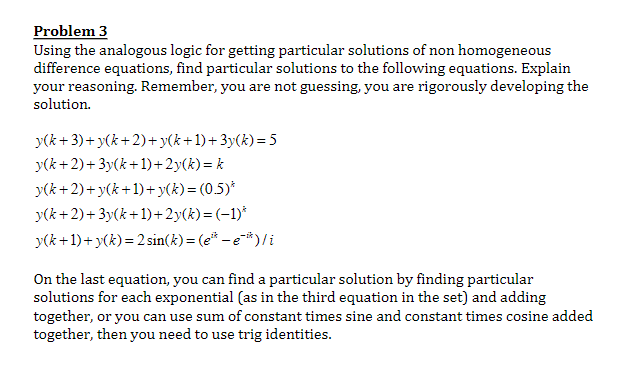Using the analogous logic for getting particular solutions of non homogeneous difference equations, find particular solutions to the following equations. Explain your reasoning. Remember, you are not guessing, you are rigorously developing the solution. y(k+3)+y(k+2)+y(k+1)+3y(k)=5 y(k+2)+3y(k+1)+2y(k)= k y(k+2)+y(k+1)+y(k)=(0.5)* y(k+2)+3y(k+1)+2y(k)=(-1)* y(k+1)+ y(k)=2 sin(k)=(e¹ - e¯*)/i On the last equation, you can find a particular solution by finding particular solutions for each exponential (as in the third equation in the set) and adding together, or you can use sum of constant times sine and constant times cosine added together, then you need to use trig identities.
Using the analogous logic for getting particular solutions of non homogeneous difference equations, find particular solutions to the following equations. Explain your reasoning. Remember, you are not guessing, you are rigorously developing the solution. y(k+3)+y(k+2)+y(k+1)+3y(k)=5 y(k+2)+3y(k+1)+2y(k)= k y(k+2)+y(k+1)+y(k)=(0.5)* y(k+2)+3y(k+1)+2y(k)=(-1)* y(k+1)+ y(k)=2 sin(k)=(e¹ - e¯*)/i On the last equation, you can find a particular solution by finding particular solutions for each exponential (as in the third equation in the set) and adding together, or you can use sum of constant times sine and constant times cosine added together, then you need to use trig identities.
Linear Algebra: A Modern Introduction
4th Edition
ISBN:9781285463247
Author:David Poole
Publisher:David Poole
Chapter2: Systems Of Linear Equations
Section2.2: Direct Methods For Solving Linear Systems
Problem 4CEXP
Related questions
Question
100%

Transcribed Image Text:Problem 3
Using the analogous logic for getting particular solutions of non homogeneous
difference equations, find particular solutions to the following equations. Explain
your reasoning. Remember, you are not guessing, you are rigorously developing the
solution.
y(k+3)+y(k+2)+y(k+1)+3y(k)=5
y(k+2)+3y(k+1)+2y(k)= k
y(k+2)+y(k+1)+y(k)=(0.5)*
y(k+2)+3y(k+1)+2y(k)=(-1)*
y(k+1)+ y(k)=2 sin(k)=(e-e)/i
On the last equation, you can find a particular solution by finding particular
solutions for each exponential (as in the third equation in the set) and adding
together, or you can use sum of constant times sine and constant times cosine added
together, then you need to use trig identities.
Expert Solution
This question has been solved!
Explore an expertly crafted, step-by-step solution for a thorough understanding of key concepts.
Step by step
Solved in 5 steps

Recommended textbooks for you

Linear Algebra: A Modern Introduction
Algebra
ISBN:
9781285463247
Author:
David Poole
Publisher:
Cengage Learning

Algebra and Trigonometry (MindTap Course List)
Algebra
ISBN:
9781305071742
Author:
James Stewart, Lothar Redlin, Saleem Watson
Publisher:
Cengage Learning

College Algebra
Algebra
ISBN:
9781305115545
Author:
James Stewart, Lothar Redlin, Saleem Watson
Publisher:
Cengage Learning

Linear Algebra: A Modern Introduction
Algebra
ISBN:
9781285463247
Author:
David Poole
Publisher:
Cengage Learning

Algebra and Trigonometry (MindTap Course List)
Algebra
ISBN:
9781305071742
Author:
James Stewart, Lothar Redlin, Saleem Watson
Publisher:
Cengage Learning

College Algebra
Algebra
ISBN:
9781305115545
Author:
James Stewart, Lothar Redlin, Saleem Watson
Publisher:
Cengage Learning

Algebra: Structure And Method, Book 1
Algebra
ISBN:
9780395977224
Author:
Richard G. Brown, Mary P. Dolciani, Robert H. Sorgenfrey, William L. Cole
Publisher:
McDougal Littell


College Algebra (MindTap Course List)
Algebra
ISBN:
9781305652231
Author:
R. David Gustafson, Jeff Hughes
Publisher:
Cengage Learning